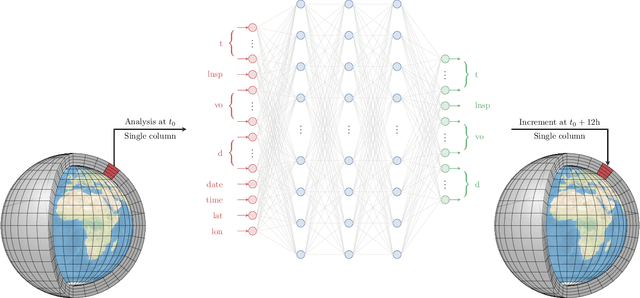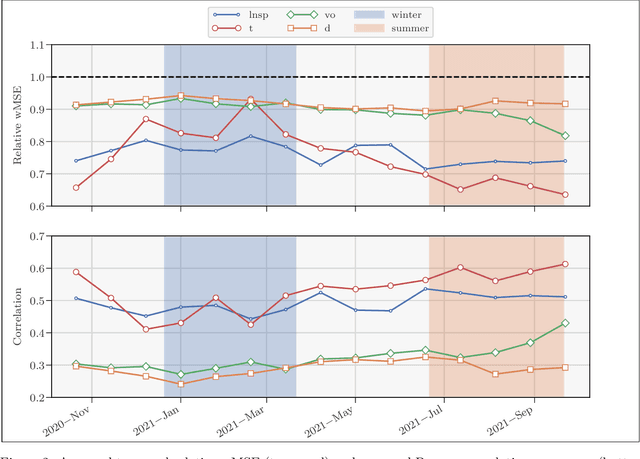Marcin Chrust
GraphDOP: Towards skilful data-driven medium-range weather forecasts learnt and initialised directly from observations
Dec 20, 2024Abstract:We introduce GraphDOP, a new data-driven, end-to-end forecast system developed at the European Centre for Medium-Range Weather Forecasts (ECMWF) that is trained and initialised exclusively from Earth System observations, with no physics-based (re)analysis inputs or feedbacks. GraphDOP learns the correlations between observed quantities - such as brightness temperatures from polar orbiters and geostationary satellites - and geophysical quantities of interest (that are measured by conventional observations), to form a coherent latent representation of Earth System state dynamics and physical processes, and is capable of producing skilful predictions of relevant weather parameters up to five days into the future.
Data driven weather forecasts trained and initialised directly from observations
Jul 22, 2024Abstract:Skilful Machine Learned weather forecasts have challenged our approach to numerical weather prediction, demonstrating competitive performance compared to traditional physics-based approaches. Data-driven systems have been trained to forecast future weather by learning from long historical records of past weather such as the ECMWF ERA5. These datasets have been made freely available to the wider research community, including the commercial sector, which has been a major factor in the rapid rise of ML forecast systems and the levels of accuracy they have achieved. However, historical reanalyses used for training and real-time analyses used for initial conditions are produced by data assimilation, an optimal blending of observations with a physics-based forecast model. As such, many ML forecast systems have an implicit and unquantified dependence on the physics-based models they seek to challenge. Here we propose a new approach, training a neural network to predict future weather purely from historical observations with no dependence on reanalyses. We use raw observations to initialise a model of the atmosphere (in observation space) learned directly from the observations themselves. Forecasts of crucial weather parameters (such as surface temperature and wind) are obtained by predicting weather parameter observations (e.g. SYNOP surface data) at future times and arbitrary locations. We present preliminary results on forecasting observations 12-hours into the future. These already demonstrate successful learning of time evolutions of the physical processes captured in real observations. We argue that this new approach, by staying purely in observation space, avoids many of the challenges of traditional data assimilation, can exploit a wider range of observations and is readily expanded to simultaneous forecasting of the full Earth system (atmosphere, land, ocean and composition).
Online model error correction with neural networks: application to the Integrated Forecasting System
Mar 06, 2024



Abstract:In recent years, there has been significant progress in the development of fully data-driven global numerical weather prediction models. These machine learning weather prediction models have their strength, notably accuracy and low computational requirements, but also their weakness: they struggle to represent fundamental dynamical balances, and they are far from being suitable for data assimilation experiments. Hybrid modelling emerges as a promising approach to address these limitations. Hybrid models integrate a physics-based core component with a statistical component, typically a neural network, to enhance prediction capabilities. In this article, we propose to develop a model error correction for the operational Integrated Forecasting System (IFS) of the European Centre for Medium-Range Weather Forecasts using a neural network. The neural network is initially pre-trained offline using a large dataset of operational analyses and analysis increments. Subsequently, the trained network is integrated into the IFS within the Object-Oriented Prediction System (OOPS) so as to be used in data assimilation and forecast experiments. It is then further trained online using a recently developed variant of weak-constraint 4D-Var. The results show that the pre-trained neural network already provides a reliable model error correction, which translates into reduced forecast errors in many conditions and that the online training further improves the accuracy of the hybrid model in many conditions.
Online model error correction with neural networks in the incremental 4D-Var framework
Oct 25, 2022Abstract:Recent studies have demonstrated that it is possible to combine machine learning with data assimilation to reconstruct the dynamics of a physical model partially and imperfectly observed. Data assimilation is used to estimate the system state from the observations, while machine learning computes a surrogate model of the dynamical system based on those estimated states. The surrogate model can be defined as an hybrid combination where a physical model based on prior knowledge is enhanced with a statistical model estimated by a neural network. The training of the neural network is typically done offline, once a large enough dataset of model state estimates is available. By contrast, with online approaches the surrogate model is improved each time a new system state estimate is computed. Online approaches naturally fit the sequential framework encountered in geosciences where new observations become available with time. In a recent methodology paper, we have developed a new weak-constraint 4D-Var formulation which can be used to train a neural network for online model error correction. In the present article, we develop a simplified version of that method, in the incremental 4D-Var framework adopted by most operational weather centres. The simplified method is implemented in the ECMWF Object-Oriented Prediction System, with the help of a newly developed Fortran neural network library, and tested with a two-layer two-dimensional quasi geostrophic model. The results confirm that online learning is effective and yields a more accurate model error correction than offline learning. Finally, the simplified method is compatible with future applications to state-of-the-art models such as the ECMWF Integrated Forecasting System.
 Add to Chrome
Add to Chrome Add to Firefox
Add to Firefox Add to Edge
Add to Edge